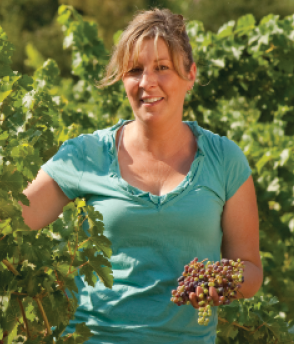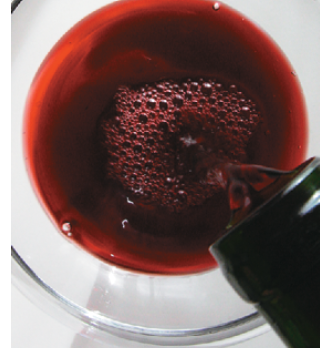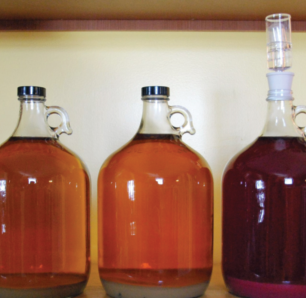Varietal wines are great, but there is only so much that can be done when working with a single grape variety. To create a truly complex wine, try blending multiple varieties that complement each other.
Winemaker: Kimberlee Nicholls, Markham Cellars, Napa Valley, California
Kimberlee Nicholls, Markham Cellars, Napa Valley, California
True blends are very challenging to create. I approach blending like cooking; sometimes you need to add a pinch of this or that to get it just right.
Understanding the texture each varietal provides works best for me. Cabernet can be tannic, Merlot and Syrah are fleshy, Petite Sirah can be juicy and Zinfandel often has jammy brightness. I suggest starting with simple proportions based upon what you are working with and then hone in on those blends that work the best. It’s tricky to not let one varietal overpower another. People don’t understand that adding 1–2% of something really can make a big difference.
I always try to keep my individual vineyards separate so that I can evaluate as to whether we want to continue with the sourcing from vintage to vintage. However, each year is different and space constraints are real concerns whether you make wine at home or in a winery. Asking questions regarding prior vintages helps give an idea of how connected the vineyard manager is to their vineyard.
Always taste your blends blind, side by side. You will have opinions based upon what you already know. A small sticker on the underside of your glass will help you focus on the blends in a more objective way. Mix them up and try and pick the same glass twice, it’s not as easy as you might think. Don’t be afraid to blend anything on a lab scale to see what works and what doesn’t work. A wine with zippy acidity might make a wine with a high pH pop and visa-versa. Keep a notebook of your blending trials; patterns eventually emerge to make it easier each year.
I personally think of all my wines as being blended wines, even though most are varietally driven. Whether
you blend for varietal or non-varietal wine, better individual components make a greater whole. Each vintage gives you something different, which is part of the beauty of what you create. One side note: Pinot Noir is a wine, in my opinion, that should never be blended with another varietal, as it is a chameleon and allows the other varietal to take over.
To take you through our thought process with a specific wine: We have a wine that pays homage to our historic stone winery, called Cellar 1879 Red Blend. At the turn of the last century, wines here in Napa Valley would have been planted as field blends with Zinfandel probably composing a majority of the blend. This is the concept I use to help me create the blend each year, with a goal to not have one varietal stand out more than another. As a Merlot house, it is no surprise that is what we use as our base. I love blending it for a velvety texture with an equal rate of Syrah comprising about half of our blend. Plus I find Syrah has the benefit of adding an interesting smoky aroma. Cabernet Sauvignon adds great backbone at 10–15%, while Petite Sirah has structure and juicy mid-palate weight when blended in at the same rate. Then I switch my focus to aromatics of Petit Verdot (violets & orange peel), Cabernet Franc (violets & chocolate), and Zinfandel (tobacco & raspberry jam). Depending upon what we have, these components might be as much as 5–8%.
 Winemaker: Eric Baugher, Ridge Vineyards’ Monte Bello Winery, Santa Cruz Mountains, California
Winemaker: Eric Baugher, Ridge Vineyards’ Monte Bello Winery, Santa Cruz Mountains, California
Many of our Zinfandel vineyards, planted in the late 1800s, were blended in the field: Mostly Zinfandel and varying amounts of Carignane and Petite Sirah interplanted. In those vineyards all of the grape varieties are picked at the same time, crushed, and fermented together. Those wines are blended right at the start of the winemaking process.
Our Bordeaux varietals at Monte Bello vineyard are harvested and fermented separately. Blending is done after five months of barrel aging, once malolactic fermentation is finished and wines are settled out. We blind taste everything in randomized order to give every varietal a chance to join the blend. We first identify the core parcels, those that strongly show vineyard character and deep flavors. Once we’ve finished tasting, the percentages are determined. Every grape in a blend needs a purpose. For example, our Monte Bello is a proprietary red wine blend, which ends up being heavy on Cabernet Sauvignon since that’s what most of the vineyard is planted to. Cabernet gives the blend its firm structure. Merlot is typically the second varietal and brings in finesse and round tannins. Cabernet Franc is the third, adding a beautiful aroma to the nose, savory herbs, and soft tannins. Petit Verdot adds dark berry fruit, violets, and big velvety tannins.
Our opinion is that the blend is a more complex and layered wine versus the more monolithic and singular character of a single-vineyard wine. Blend grapes within their varietal families, which will combine to create a much more interesting wine. For instance, Zinfandel should be blended with its traditional complementary grape varieties like Carignane, Petite Sirah, Mataro, and Alicante Bouschet. Do the bench trials blind, adding different percentages (i.e. 5-10-15%) and see which one makes the better wine.
 Kimberlee Nicholls, Markham Cellars, Napa Valley, California
Kimberlee Nicholls, Markham Cellars, Napa Valley, California
 Winemaker: Eric Baugher, Ridge Vineyards’ Monte Bello Winery, Santa Cruz Mountains, California
Winemaker: Eric Baugher, Ridge Vineyards’ Monte Bello Winery, Santa Cruz Mountains, California





